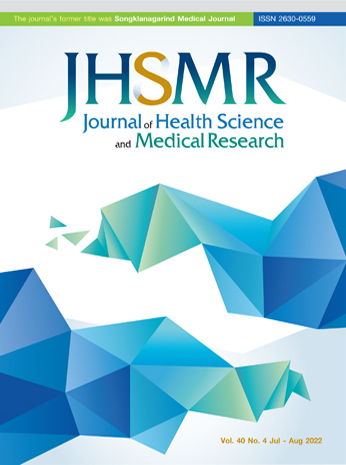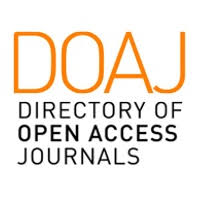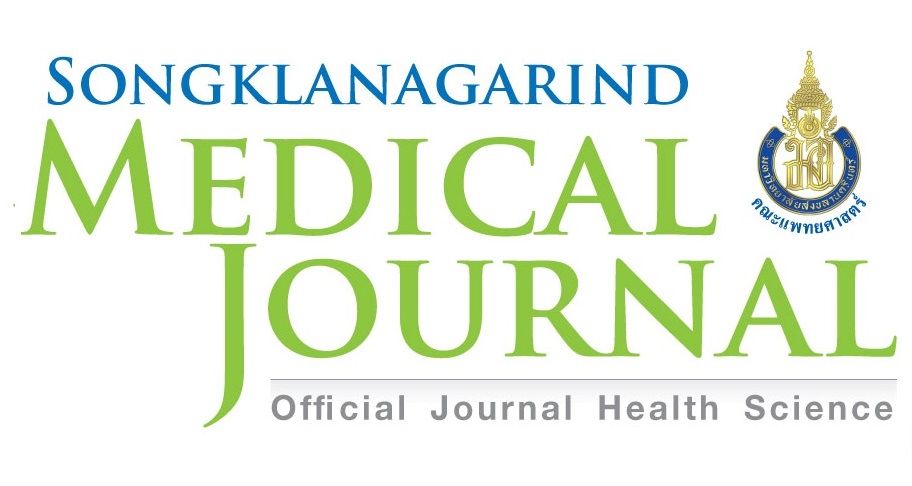The Occurrence of Antibiotic Resistant Bacteria Contamination in Sub-district Health-promoting Hospitals in Chiang Rai, Thailand
DOI:
https://doi.org/10.31584/jhsmr.2021857Keywords:
antibiogram profiles, antibiotic resistant bacteria, sub-district health-promoting hospitalsAbstract
Objective: To determine the antibiotic susceptibility patterns (antibiogram profiles) of the bacterial agents usually involved in hospital-acquired infections found in 12 sub-district health-promoting hospitals (HPHs) in Chiang Rai, Thailand.
Material and Methods: Swabs from 10 different sampling points in each sub-district HPH were aseptically collected. Standard microbiological methods were performed to define the bacterial species. Antibiotic susceptibility was determined by the disk diffusion method following the standard guidelines of the Clinical and Laboratory Standards Institute (2016).
Results: The antibiogram profiles of the 153 isolated bacteria showed that 55.6% of the isolates were resistant to antibiotics. Single drug resistant, double drug resistant, and multi-drug resistant bacteria accounted for 18.3%, 18.3%, and 19.0%, respectively. The Pseudomonas aeruginosa isolate was susceptible to all tested antibiotics. MDR phenotypes were most common in coagulase-negative staphylococci (13.1%), followed by members of the family of Enterobacteriaceae (3.9%) and Staphylococcus aureus (0.7%).
Conclusion: The MDR rates reported in this study are “worrying”. These results suggest that sub-district HPHs may become sources of HAIs caused by antibiotic-resistant bacteria which can be inevitably transmitted into the wider community. Antibiotic stewardship, antibiotic susceptibility surveillance and hygiene practices may be used to prevent and limit the spread of such bacteria from sub-district HPHs to the community.
References
Suleyman G, Alangaden G, Bardossy AC. The role of environmental contamination in the transmission of nosocomial pathogens and healthcare-associated infections. Curr Infect Dis Rep 2018;20:1-11.
Facciol A, Pellican GF, Visalli G, Paolucci IA, Venanzi RE, Ceccarelli M, et al. The role of the hospital environment in the healthcare-associated infections: a general review of the literature. Eur Rev Med Pharmacol Sci 2019;23:1266-78.
Thamlikitkul V, Rattanaumpawan P, Boonyasiri A, Pumsuwan V, Judaeng T, Tiengrim S, et al. Thailand antimicrobial resistance containment and prevention program. J Glob Antimicrob Resist 2015;3:290-4.
Webb GF, D'Agata EM, Magal P, Ruan S. A model of antibioticresistant bacterial epidemics in hospitals. Proc Natl Acad Sci USA 2005;102:13343-8.
Cai L, Sun J, Yao F, Yuan Y, Zeng M, Zhang Q, et al. Antimicrobial resistance bacteria and genes detected in hospital sewage provide valuable information in predicting clinical antimicrobial resistance. Sci Total Environ 2021;15:148815.
Khamsarn S, Nampoonsak Y, Busamaro S, Tangkoskul T, Seenama C, Rattanaumpawan P, et al. Epidemiology of antibiotic use and antimicrobial resistance in selected communities in Thailand. J Med Assoc Thai 2016;99:270-5.
O’Hara LM, Calfee DP, Miller LG, Pineles L, Magder LS, Johnson JK, et al. Optimizing contact precautions to curb the spread of antibiotic-resistant bacteria in hospitals: a multicenter cohort study to identify patient characteristics and healthcare personnel interactions associated with transmission of methicillin- resistant Staphylococcus aureus. Clin Infect Dis 2019; 69(Suppl 3):S171-7.
Sevin T, Goldstein V, Lolom I, Lenne F, Gaudonnet Y, Baptiste AL, et al. Bathroom contamination by antibiotic-resistant Enterobacterales (ESBLPE and CPE): an experimental study. J Hosp Infect 2020;106:271-6.
Pipobwatthana P, Pummangura C, Jaroennon S, Tribuddharat C, Thuncharoon H, So-Ngern A, et al. Prevalence and antibiogram profiles of Staphylococcus aureus isolates from patients at Taksin Hospital, Bangkok, Thailand (January 2019- May 2020). Southeast Asian J Trop Med Public Health 2021; 52:230-9.
Preeprem S, Bhoopong P, Srinitiwarawong K, Vuddhakul V, Mittraparp-arthorn P. Antibiogram profiles and virulence characteristics of pandemic Vibrio parahaemolyticus isolates from diarrheal patients in Hat Yai hospital, Southern Thailand. Southeast Asian J Trop Med Public Health 2019;50:132-45.
Onmek N, Kongcharoen J, Singtong A, Penjumrus A, Junnoo S. Environmental factors and ventilation affect concentrations of microorganisms in hospital wards of Southern Thailand. J Environ Public Health 2020;2020. doi: 10.1155/2020/7292198.
Seng R, Kitti T, Thummeepak R, Kongthai P, Leungtongkam U, Wannalerdsakun S, Sitthisak S. Biofilm formation of methicillinresistant coagulase negative staphylococci (MR-CoNS) isolated from community and hospital environments. PLoS One 2017;12:e0184172.
Thamlikitkul V, Tiengrim S, Thamthaweechok N, Buranapakdee P, Chiemchaisri W. Contamination by antibiotic-resistant bacteria in selected environments in Thailand. Int J Environ Res Public Health 2019;16:3753.
Chansareewittaya K, Krajangcharoensakul S. Existence of bacterial contamination on inanimate surfaces and equipment in sub-district health-promoting hospitals in Chiang Rai, Thailand. J Curr Sci Technol 2021;11:355-66.
Ducel G, Fabry J, Nicolle L. Prevention of hospital-acquired infections: a practical guide. 2nd ed. Geneva: World Health Organization; 2002.
Horan TC, Andrus M, Dudeck MA. CDC/NHSN surveillance definition of health care–associated infection and criteria for specific types of infections in the acute care setting. Am J Infect Control 2008;36:309-32.
Khan HA, Ahmad A, Mehboob R. Nosocomial infections and their control strategies. Asian Pac J Trop Biomed 2015;5:509-14.
Department of Medical Sciences, Ministry of Public Health, Thailand. Sampling and safety guide. Bangkok: Text and Journal; 2014.
Brown A, Smith H. Benson’s microbiological applications: laboratory manual in general microbiology. 13th ed. New York: The McGraw-Hill; 2012.
Bauer AW, Kerby WMM, Sherris JC, Turk M. Antibiotic susceptibility testing by a standardized single disk method. Am J Clin Pathol 1996;45:493–6.
CLSI. Performance Standards for Antimicrobial Susceptibility Testing. 26th ed. CLSI supplement M100S. Wayne, PA: Clinical and Laboratory Standards Institute; 2016.
Magiorakos AP, Srinivasan A, Carey RB, Carmeli Y, Falagas ME, Giske CG, et al. Multidrug-resistant, extensively drugresistant and pandrug-resistant bacteria: an international expert proposal for interim standard definitions for acquired resistance. Clin Microbiol Infect 2012;18:268-81.
Lalami AE, Touijer H, Ettayebi M, Benchemsi N. Microbiological monitoring of environment surfaces in a hospital in Fez city, Morocco. J Mater Environ Sci 2016;7:123-30.
Shaheen A, Baqai R. Biofilm Formation by Environmental Microbes Isolated from Hospitals in Karachi, Pakistan. Am Sci Res J Eng Technol Sci 2016;15:240-51.
Kramer A, Schwebke I, Kampf G. How long do nosocomial pathogens persist on inanimate surfaces? A systematic review. BMC Infect Dis 2006;6:1-8.
Juda M, Chudzik-Rzad B, Malm A. The prevalence of genotypes that determine resistance to macrolides, lincosamides, and streptogramins B compared with spiramycin susceptibility among erythromycin-resistant Staphylococcus epidermidis. Mem Inst Oswaldo Cruz 2016;111:155-60.
Lina G, Quaglia A, Reverdy ME, Leclercq R, Vandenesch F, Etienne J. Distribution of genes encoding resistance to macrolides, lincosamides, and streptogramins among staphylococci. Antimicrob Agents Chemother 1999;43:1062-6.
Steward CD, Raney PM, Morrell AK, Williams PP, McDougal LK, Jevitt L, et al. Testing for induction of clindamycin resistance in erythromycin-resistant isolates of Staphylococcus aureus. J Clin Microbiol 2005;43:1716-21.
Patel M, Waites KB, Moser SA, Cloud GA, Hoesley CJ. Prevalence of inducible clindamycin resistance among community-and hospital-associated Staphylococcus aureus isolates. J Clin Microbiol 2006;44:2481-4.
Tajeddin E, Rashidan M, Razaghi M, Javadi SS, Sherafat SJ, Alebouyeh M, et al. The role of the intensive care unit environment and health-care workers in the transmission of bacteria associated with hospital acquired infections. J Infect Public Health 2016;9:13-23.
Poeschl PW, Spusta L, Russmueller G, Seemann R, Hirschl A, Poeschl E, et al. Antibiotic susceptibility and resistance of the odontogenic microbiological spectrum and its clinical impact on severe deep space head and neck infections. Oral Surg Oral Med Oral Pathol Oral Radiol Endod 2010;110: 151-6.
Peric s JM, Nathavitharana R, Garcia-de-la-M ria C, Falces C, Ambrosioni J, Almela M, et al. Endocarditis caused by highly penicillin-resistant viridans group streptococci: still room for vancomycin-based regimens. Antimicrob Agents Chemother 2019;63:e00516-19.
Eshetie S, Unakal C, Gelaw A, Ayelign B, Endris M, Moges F. Multidrug resistant and carbapenemase producing Enterobacteriaceae among patients with urinary tract infection at referral Hospital, Northwest Ethiopia. Antimicrob Resist Infect Control 2015;4:1-8.
Raji MA, Jamal W, Ojemhen O, Rotimi VO. Point-surveillance of antibiotic resistance in Enterobacteriaceae isolates from patients in a Lagos Teaching Hospital, Nigeria. J Infect Public Health 2013;6:431-7.
Ullah W, Qasim M, Rahman H, Bari F, Khan S, Rehman ZU, et al. Multi drug resistant Pseudomonas aeruginosa: pathogen burden and associated antibiogram in a tertiary care hospital of Pakistan. Microb Pathog 2016;97:209-12.
Godebo G, Kibru G, Tassew H. Multidrug-resistant bacterial isolates in infected wounds at Jimma University Specialized Hospital, Ethiopia. Ann Clin Microbiol Antimicrob 2013;12:1-7.
Moges F, Endris M, Belyhun Y, Worku W. Isolation and characterization of multiple drug resistance bacterial pathogens from waste water in hospital and non-hospital environments, Northwest Ethiopia. BMC Res Notes 2014;7: 1-6.
Khan HA, Baig FK, Mehboob R. Nosocomial infections: epidemiology, prevention, control and surveillance. Asian Pac J Trop Biomed 2017;7:478-82.
Farooq L, Memon Z, Ismail MO, Sadiq S. Frequency and antibiogram of multi-drug resistant Pseudomonas aeruginosa in a Tertiary Care Hospital of Pakistan. Pak J Med Sci 2019;35: 1622–6.
Downloads
Published
How to Cite
Issue
Section
License

This work is licensed under a Creative Commons Attribution-NonCommercial-NoDerivatives 4.0 International License.
























